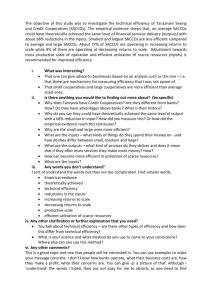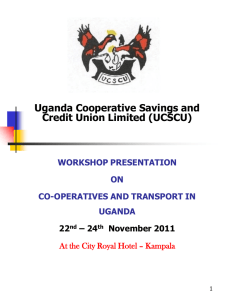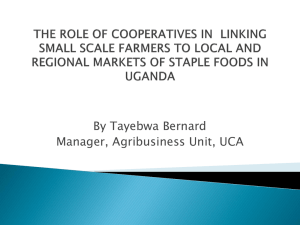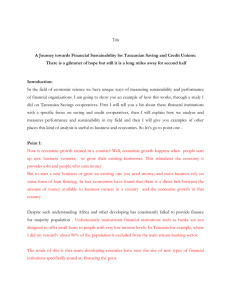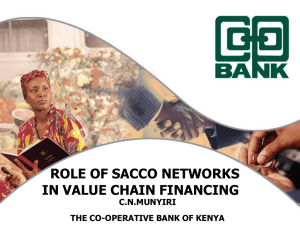Document 14249115
advertisement
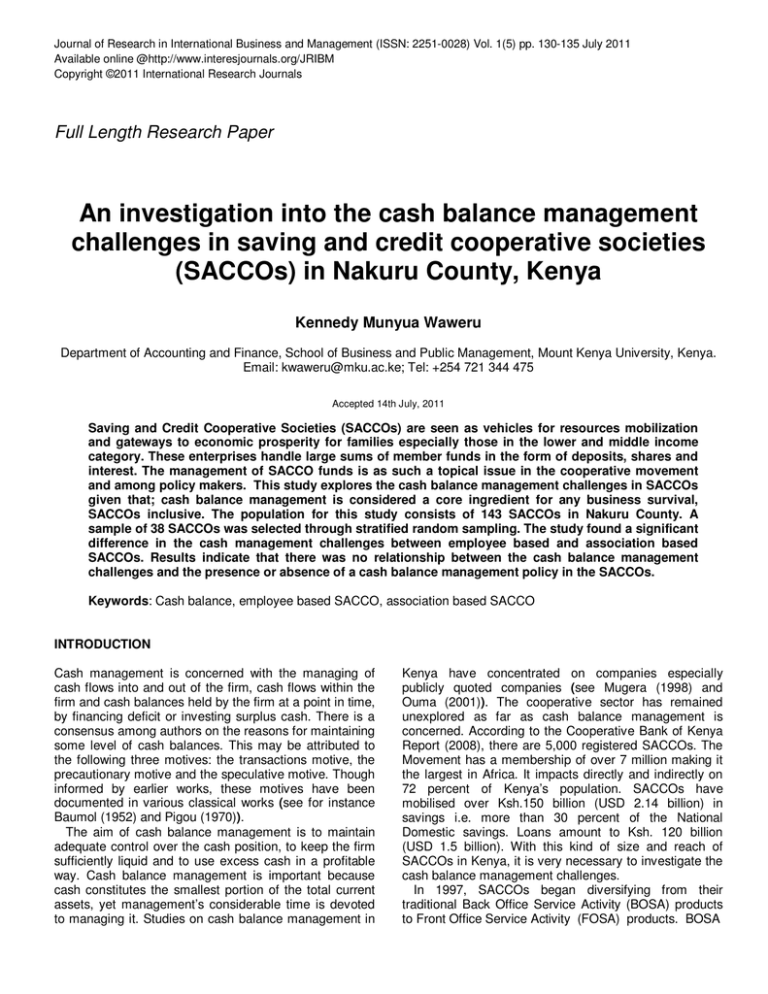
Journal of Research in International Business and Management (ISSN: 2251-0028) Vol. 1(5) pp. 130-135 July 2011 Available online @http://www.interesjournals.org/JRIBM Copyright ©2011 International Research Journals Full Length Research Paper An investigation into the cash balance management challenges in saving and credit cooperative societies (SACCOs) in Nakuru County, Kenya Kennedy Munyua Waweru Department of Accounting and Finance, School of Business and Public Management, Mount Kenya University, Kenya. Email: kwaweru@mku.ac.ke; Tel: +254 721 344 475 Accepted 14th July, 2011 Saving and Credit Cooperative Societies (SACCOs) are seen as vehicles for resources mobilization and gateways to economic prosperity for families especially those in the lower and middle income category. These enterprises handle large sums of member funds in the form of deposits, shares and interest. The management of SACCO funds is as such a topical issue in the cooperative movement and among policy makers. This study explores the cash balance management challenges in SACCOs given that; cash balance management is considered a core ingredient for any business survival, SACCOs inclusive. The population for this study consists of 143 SACCOs in Nakuru County. A sample of 38 SACCOs was selected through stratified random sampling. The study found a significant difference in the cash management challenges between employee based and association based SACCOs. Results indicate that there was no relationship between the cash balance management challenges and the presence or absence of a cash balance management policy in the SACCOs. Keywords: Cash balance, employee based SACCO, association based SACCO INTRODUCTION Cash management is concerned with the managing of cash flows into and out of the firm, cash flows within the firm and cash balances held by the firm at a point in time, by financing deficit or investing surplus cash. There is a consensus among authors on the reasons for maintaining some level of cash balances. This may be attributed to the following three motives: the transactions motive, the precautionary motive and the speculative motive. Though informed by earlier works, these motives have been documented in various classical works (see for instance Baumol (1952) and Pigou (1970)). The aim of cash balance management is to maintain adequate control over the cash position, to keep the firm sufficiently liquid and to use excess cash in a profitable way. Cash balance management is important because cash constitutes the smallest portion of the total current assets, yet management’s considerable time is devoted to managing it. Studies on cash balance management in Kenya have concentrated on companies especially publicly quoted companies (see Mugera (1998) and Ouma (2001)). The cooperative sector has remained unexplored as far as cash balance management is concerned. According to the Cooperative Bank of Kenya Report (2008), there are 5,000 registered SACCOs. The Movement has a membership of over 7 million making it the largest in Africa. It impacts directly and indirectly on 72 percent of Kenya’s population. SACCOs have mobilised over Ksh.150 billion (USD 2.14 billion) in savings i.e. more than 30 percent of the National Domestic savings. Loans amount to Ksh. 120 billion (USD 1.5 billion). With this kind of size and reach of SACCOs in Kenya, it is very necessary to investigate the cash balance management challenges. In 1997, SACCOs began diversifying from their traditional Back Office Service Activity (BOSA) products to Front Office Service Activity (FOSA) products. BOSA Waweru 131 products include: Long term loans granted for development purposes, usually for a period of 24 - 48 months and short term loans granted for school fees or emergency purposes with interest rate for both types of loans charged at 12 percent per annum on a reducing balance, while FOSA products range from deposit facilities such as fixed deposit accounts, savings accounts, short/call deposit, special accounts e.g. children, holiday, medical, school fees etc to credit facilities such as advances, short term loans and emergency loans. Interest rates for these products range from 1.5 percent per month to as high as 5 percent per month. Other products offered by FOSA include: Cheque clearing facilities, and banker’s cheques through Cooperative Bank of Kenya, safe custody facilities, standing orders, salary processing, electronic funds transfer and automated teller machines through SACCO Link facility with Cooperative Bank of Kenya. With the diversification in financial services offered by SACCOs, the borderline between the services offered by commercial banks became more and more blurred. It therefore became necessary over time to provide specific regulatory framework for SACCOs. The SACCO Societies Act No. 14 of 2008 whose commencement date was 26th September 2009 and the Sacco Societies (Deposit Taking Sacco Business) Regulations, 2010 whose commencement date was 18th June 2010, became the legal framework informing the SACCO sector in Kenya. Before 2009, the cooperative movement in Kenya was guided by the Co-operative Act (Co-operative Societies Rule Number 12 of 1997) as amended in 2004. The diversification also meant that the cash balance management function in SACCOs became more and more critical in the provision of efficient services. According to Microfinance House Limited (2006), the average loan waiting period in the SACCOs, is 6 months due to poor cash flow position. There is therefore need for socially responsive and profitable SACCOs and good cash balance management strategies are necessary to enhance the performance of the SACCOs. Poor cash balance management leads to high opportunity costs of holding cash, where large amounts of funds lie idle in the firm and also cash-out costs where the firm is unable to meet its financial obligations as and when they fall due. Yet there is little knowledge of research on the challenges of cash balance management in the cooperative sector. This study explores cash balance management challenges of SACCOs, in Nakuru County of Kenya. According to the National Census Report (2010) Nakuru County had a population of 1.6 million people in 2009. Nakuru County has 143 active registered SACCOs out of which 117 SACCOs are employee based SACCOs while 26 are association based. Categorization of SACCOs based on nature of cash receipts The study categorizes SACCOs into employee based and association based on the pattern of cash receipts. Employee based SACCOs have certain, predictable and controllable cash receipts. This is due to the fact that cash receipts are mainly done through a check-off system. On the other hand association based SACCOs may not be able to adequately predict the cash receipts because of the lack of a check-off system. In light of this fact the different categories of SACCOs may be best suited to apply the different models due to their unique characteristics. The study objective The study objective was to find out the challenges of cash balance management in SACCOs. The study hypothesized as follows: 1. Cash balance management challenges are related to cash balance management policies employed by the SACCOs 2. Cash management challenges in employee based SACCOs are significantly different from the cash balance management challenges in association based SACCOs Theoretical Framework Models on cash balance management have been proposed by Baumol (1952), Archer (1966), Beranek (1963), Miller and Orr (1966), (Pigou, 1970), Lockyer (1973), and Gibbs (1976) among others. William Baumol (1952) was the first person to provide a formal model of cash management. This model applied the economic order quantity (EOQ) to cash. Brokerage fees and clerical work form order costs while foregone interest and cash out costs form the costs of holding cash. Baumol’s model has the following limitations: The model assumes the firm has a constant disbursement rate. The model also assumes there are no cash receipts during the projected period and no safety stock is allowed for. Baumol’s model is however probably the simplest, most striped down and sensible model for determining the optimal cash position (Ross, 1990). Its chief weakness is that it assumes discrete and certain cash flows. In an attempt to remedy Baumol’s reliance on constant cash flows, Miller and Orr (1966) developed a cash balance model to deal with cash inflows and outflows that fluctuate randomly from day to day. In the Miller-Orr 132 J. Res. Int. Bus. Manag. model both cash inflows and outflows are not included. The model assumes that the distribution of daily net cash flows is normally distributed. The model operates in terms of upper (H) and lower (L) control limits and a target cash balance (Z). The cash balance is allowed to wander randomly between H and L. The firm only makes a cash balance transaction if the cash balance reaches H, when the firm buys H-Z marketable securities or if the cash balance reaches L, when the firm sells Z- L marketable securities. The firm sets L depending on how much cash shortfall it is willing to bear. The cost of selling and buying marketable securities (F) are assumed to be fixed. The percentage opportunity cost per period of holding cash (K) is the daily interest rate on marketable securities. Unlike Baumol’s model, the number of transactions per period is a random variable that varies from period to period, depending on the pattern of cash inflows and outflows. The implications of the Miller-Orr model is that the manager must fulfill four conditions: Set the lower limit for the cash balance; Estimate the standard deviation of daily cash flows; Determine the interest rates and Estimate the trading costs of buying and selling marketable securities. Beranek (1963) came up with a different approach to cash management. This approach hinges upon optimal allocation of funds between cash balance and marketable securities. Beranek contends that in so far as cash flows are controllable and recur in a cyclical manner, the financial manager can predict cash needs over the planning period and invest the amount considered surplus. In his approach however Beranek does not give light to what constitutes the critical minimum balance. This approach also assumes predictable cash inflows. Lockyer (1973) on the other hand modified Baumol’s model to incorporate overdraft facilities. According to Lockyer’s approach the total annual cash policy cost attributable to the use of overdraft facilities is given by the sum of total annual cash transfer cost, total annual overdraft cost and the total annual holding cost. Lockyer’s model is critiqued for assuming overdraft facilities, which are not automatic especially for firms with poor credit rating. The model also assumes disbursements are even over the planning period. The cyclical nature of cash is recognized by Archer (1966) who reasons that apart from providing a cash balance for transactional purposes, a cash balance should be provided for precautionary purposes, especially for seasonal activities that are unpredictable. In Archer’s approach, costs related to overdraft facilities and capital costs of precautionary balances are compared to determine the optimum. Archer’s approach is advantageous for it recognizes the cyclical nature of net cash flows of many firms. Gibbs (1976) enhances the reasoning by Archer (1956). According to Gibbs, the determination of optimal cash balance involves a combination of investment and financial decisions. In Gibbs approach, cases where demand for money is of a cyclical nature a combination of short and long term borrowing should be used to avoid the use of long term funds to cover peaks arising from idle cash balance, during periods of low cash demand. Gibbs contends that, the determination of the amount of buffer money to hold is seen as an investment decision. Gibbs approach emphasizes holding costs, costs of short and costs of long-term borrowing and the costs of investment in marketable securities. Despite their enormous limitation and lack of flexibility to incorporate all the information generated by financial managers, models perform effectively if they capture the critical elements in decision problems. MATERIALS AND METHODS Methods This study employed a survey as its research design. The purpose of a survey is to explore and describe observed phenomena, (Kathuri and Pals, 1993). Surveys are effective in obtaining information relating to people’s thoughts feelings and opinions. Surveys are suitable where the population under study is relatively large and the phenomenon under investigation can be observed directly by the researcher, (Borg and Gall, 1983). The target area of the study was Nakuru County in Kenya. The target population consisted of the 205 SACCOs in the County, However 62 of the 205 SACCOs were dormant, and thus the study was based on the 143 active SACCOs. A sample of 38 SACCOs was taken. Stratified random sampling was used to ensure proportionate representation of the two categories of SACCOs (employee and association based SACCOs) in the sample. Each of the 143 SACCOs formed a sampling unit. The stratification was based on employee based SACCOs and association based SACCOs. This was in order that each stratum or category formed a sampling frame. Items in each stratum were arranged alphabetically and numbered. Computer generated random numbers were then used to select the 38 SACCOs to be included in the sample. Given that n=38 and N=143, the sampling fraction was more than adequate. Borg and Gall, (1983) recommend a sampling fraction of at least 0.25. Materials The study used both primary and secondary data. Questionnaires were used to collect data pertaining to the cash balance management challenges in SACCOs. Questionnaires were also used to identify factors influencing the choice of the cash balance management Waweru 133 policies. Data relating to the level of cash planning was obtained from the County Co-operative records and the Kenya Union of Saving and Credit Societies (KUSCCO) records. The items in the instruments were standardized for validity using Cronbach’s Alpha procedure. The instruments were pre-tested in three SACCOs in Baringo County and two SACCOs in Nakuru County which were not included in the sample. Appropriate modifications were made on the questionnaires after pre-testing for the purpose of achieving the objectives the study. Questionnaires were administered personally Data on cash balance management challenges employed by the SACCOs was analyzed using descriptive statistics. The study hypothesis was tested using the t-test. Capacity to lend limited by deposits/shares All the SACCOs surveyed were not able to meet members’ demand for loans. In some SACCOs it took up to a year to be able to get loans. The ability to lend was limited by members’ shares/deposits and the fact that members could access loans amounting to between 2 and 3 times the amount of their deposits. This was further exacerbated by the increasing number of deaths related to HIV/AIDS. The normal policy in cases of deaths was to write off the members loans and refund up to two times the member’s deposits. This severely affected the cash flow and the cash balance management function. Specific policy on cash balance management RESULTS AND DISCUSSION Information Technology Only 8.9 percent of the SACCOs had computerized cash monitoring system. A majority of SACCOs operated on manual records. In some SACCOs the bookkeepers were SACCO members with no training in accounting. This indicated a gap in the management of cash balances. Ouma (2001) found out that 61 percent of the companies quoted at the NSE had computerized cash monitoring systems. This points to a wide variation with the finding. Members ever changing needs/demands 83 percent of the SACCOs indicated that member’s everchanging needs posed a significant challenge for cash balance management. The major demands on the cash management function emanated from the effects of HIV/AIDS related deaths, decline in membership occasioned by withdrawals and retirement; and employers’ apathy in the form of delayed or nonremittance of members contribution especially in the employee-based SACCOs Weak internal controls 89 percent of the SACCOs had weak internal controls with only one or two officers performing bookkeeping, recording, safekeeping and cahier functions, this led to incidences of fraud and forgeries. Additionally the financial management function was found to be deficient in 68 percent of the SACCOs where key financial personnel did not have adequate training in financial management. Only 21 percent of the SACCOs had put in place specific policies on cash balances. Findings however indicate that 70 percent of the SACCOs were aware of the need to have cash balance management policies. The lack of a policy on cash balance management was found to be a major challenge in the management of cash balances. In comparison Ouma (2001) found out that 67 percent of quoted companies on the NSE had specific policies on cash balance management. Relationship between balance management challenges and the type of SACCO category The cash balance management challenges related to; lack of cash balance management policy, failure to specify the minimum and maximum cash balances, lack of cash planning, cash-outs and a longer loan waiting period (average, 6 months). It was found out that cash balance management challenges were unique to individual categories of SACCOs. The results indicated that there was a significant difference (at 95 percent confidence level) in the cash management challenges between employee and association based SACCOs as indicated in table 1. Relationship between cash balance management challenges and the presence or absence of cash balance management policies Results in table 2 indicate that there was no significant difference between those SACCOs that had put in place cash management policies and those that had not. Therefore cash management problems were not necessarily related to the cash management policies. 134 J. Res. Int. Bus. Manag. Table 1: T-test output of cash balance management challenges in employee and association based SACCOs Levene’s Test for Equality of Variances F Sig t-test for Equality of Means t df Sig tailed 2-Mean Difference Std. Error Difference Equal variances assumed -2.584 36 .014* -1.5500 .5998 1.751 .194 95% Confidence interval of the difference Lower Upper -2.7665 -.3335 *Significant at 95 percent confidence level Table 2: T-test output of cash balance management challenges and cash balance management policies Levene’s Test for Equality of Variances F Sig Equal variances assumed 1.532 .137 t-test for Equality of Means t df Sig tailed 2-Mean Difference Std. Error Difference -.0989 36 .09218 -1.3362 .4652 SUMMARY AND CONCLUSIONS The objective of the study was to find out the cash balance management challenges in the employee and association based SACCOs by first testing the proposition that, cash balance management challenges were related to the presence or lack of cash balance management policies. The findings indicate that there was no significant differences in cash balance management challenges between the SACCOs that had put in place cash balance management polices and those that had not. It may therefore be concluded that there is no relationship between the cash balance management challenges and cash balance management policies. This is an indication that cash management challenges may not be due to presence or absence of a policy on cash balance management. Some of the challenges were beyond the control of SACCOs such as the effects of HIV/AIDS and delayed or none remittances of members contributions by employers. Secondly the study tested the hypothesis that, cash balance management challenges were unique to individual categories of SACCOs. Given that results indicated a significant difference in the cash balance management challenges between the employee and association based SACCOs, it can be concluded that 95% Confidence interval of the difference Lower Upper -3.4931 1.2276 indeed the cash balance management challenges were unique to individual SACCO categories, a trend that was attributed to the lack of a check-off system since this was the basis of stratification of the SACCOs. It would be advisable for the SACCOs without a check-off system to strengthen measures in cash management in order to control cash receipts. It was also found necessary to enhance the internal control systems The level of computerization in the SACCOs was found to be very low. This may be attributed to the fact that most of the SACCOs were in their early stages of development. However those well established SACCOs were found to have computerized their operations but lacked a computerized cash balance management system. It would be advisable that SACCOs computerize their operations especially on cash balances monitoring. A majority of SACCOs were not keen on using credit facilities as they entirely depended on members’ contributions, which severely limited their lending capabilities. This finding may be attributed to the fact that SACCOs lend at a relatively lower interest rate than what is charged on overdrafts by banks. This makes it infeasible to borrow from banks. Other businesses like those studied by (Ouma, 2001), depend on overdrafts to finance their working capital. Waweru 135 REFERENCES Archers S (1966). A model for determination for firms Cash Balances. J. Financ. Quant. Anal. 1(1):1-11 Baumol WJ (1952). The Transactions Demand for Cash: An Inventory Theoretical Approach, Quarterly J. Econ. 66 (4): 545-556 Beranek W (1963). Analysis for Financial Decisions. Boston. Irwin Borg WR and Gal MD (1983). Educational Research: An introduction. Longman New York pp. 244-248 Cooperative Bank of Kenya (2008). Cooperative Bank of Kenya Report on the SACCO Movement in Kenya at the AFRACA Workshop. Nairobi,Kenya.http://www.afraca.org/main.php?maim=reports&album =5 [Accessed 10th December, 2010] Gibbs NCW (1976). The Demand of Money by Firms: A Review and Buffer Stock Simulation Model. Government of Kenya. (2004). Co-operative Act (Co-operative Societies Rule Number 12 of 1997) as amended in 2004. Nairobi: Government Press. Government of Kenya. (2008). SACCO Societies Act No. 14 of 2008. Nairobi: Government Press Government of Kenya (2010). Sacco Societies (Deposit Taking Sacco Business) Regulations. Nairobi: Kenya Gazette Kathuri NJ and Pals AD (1993). Introduction to Educational Research. Njoro:Egerton, University. Kenya National Bureau of Statistics. (2010). 2009 National Census Report. Nairobi: KNBS Lockyer KG (1973). Cash as an Item of Stock. J. Bus. Financ. 1(5):4451. Microfinance House Ltd (2006). Background Information on SACCOs. Presented in AFRACA Workshop on the Role of Women in the Development of Microfinance in Africa Miller M H and Orr D (1966). A Model of the Demand for Money by Firms. Q. J. Econ. 80: 413-443 Ministry of Co-operative Development (1983). Investments in Kenya Cooperatives. Unpublished Research Paper. Mugera PM (1998). Cash Management Practices in Small Business Enterprises: Case Study. Unpublished Thesis. United States International University- Africa. Ouma S (2001). A Survey of Cash Management Approaches by Firms Quoted in the NSE. Unpublished Thesis. University of Nairobi Pigou GA, Faucett RB, and Bussard RN (1970). Cash Management: A Systems Approach Industrial Management Review. Pp. 55-74 Ross SA (1990). Corporate Finance. Boston. Richard D Irwin Inc
